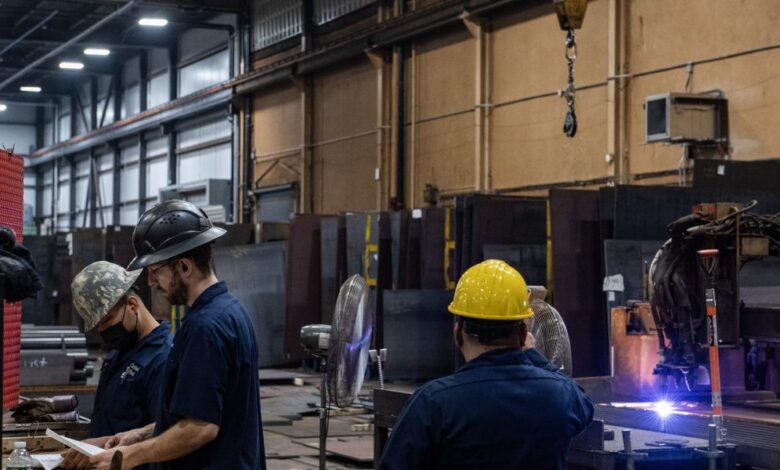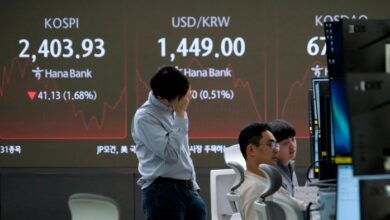U.S. manufacturers are on edge as Trump’s ‘Liberation Day’ tariffs loom: ‘We need to make decisions but the ball is constantly moving’


- The manufacturing sector tends to be more cyclical than other industries, so it can be particularly useful for understanding how the broader economy is changing. The Dallas Fed’s monthly survey suggests many firms are already fed up as tariff uncertainty weighs on sales and makes planning difficult.
Businesses are on edge on the eve of “Liberation Day,” with President Donald Trump set to announce his administration’s biggest batch of tariffs yet on U.S. trading partners. For better or worse, American manufacturers will be among the companies most impacted by the ongoing shift in U.S. trade policy, and the monthly sector survey from the Federal Reserve Bank of Dallas provides a glimpse of what some firms are feeling.
Respondents haven’t been as pessimistic about their companies’ prospects since July, and the index’s “uncertainty index” posted its highest reading since the fall of 2022, just after inflation had peaked at a four-decade high. Paul Donovan, the chief economist at UBS Global Wealth Management, believes this type of sentiment data often reveals little more than the influence of partisan thinking. He thinks the comments section has value, though, and it was chock full of complaints about tariffs.
“There may be selection bias (surveys are generally completed by people who want to complain),” Donovan wrote in a note Tuesday morning, “but the level of concern was striking. Much of the focus was on the uncertainty of erratic policy making rather than tariff levels as such.”
Roughly 84 Texas firms, which were polled between March 18-26, spelled out how Trump’s on-again, off-again tariff threats have or will likely impact their business.
“We do not know what prices we will have to pay for components, and we do not know how customers will respond to increases strictly related to tariffs,” said one computer and electronics manufacturer.
The firm said it had already lost opportunities building products used in other countries but was unsure whether tariffs would bring new business from foreign companies wanting to build in the U.S.
“That remains to be seen, but the known risk currently seems to outweigh the unknown opportunity,” the respondent said.
The manufacturing sector tends to be more cyclical than other industries, so the Dallas Fed says it can be particularly useful for understanding how the broader economy is changing. Another computer and electronics maker said macroeconomic headwinds could force it to close shop, but another respondent in the same industry largely dismissed pessimism about business conditions.
“Despite all of the doomsaying in the press, we are not seeing any drop in orders,” the firm said. “We have invested heavily in equipment and production capacity in the last 12 months and are seeing the benefits from that now. While a short recession is a possibility due to the reductions in government spending, we view this as a net positive for the economy and our business in the medium term.”
Will “Liberation Day” provide clarity?
Markets received a boost last week after Trump downplayed expectations for Wednesday’s big tariff announcement. The tune from the administration has changed again, however, with The Wall Street Journal reporting over the weekend that a blanket 20% tariff on all imports is on the table. The White House has also pushed back on previous reports that so-called reciprocal tariffs on trading partners might be narrowed, with the president telling reporters Sunday the new taxes will target “all countries.”
Trump has already increased America’s effective tariff rate from 2.5% to 9%, according to UBS—the highest level since World War II—and the firm expects the new taxes unveiled on Wednesday will push it four percentage points higher. Once the latest tariffs are announced, UBS wrote Tuesday, negotiations to soften them can begin.
But firms still don’t know how long these tariffs will be in force, and one mineral-product manufacturer said it had not encountered this level of uncertainty in nearly 50 years of doing business.
“We need to make decisions,” the respondent said, “but the ball is constantly moving. This is truly ridiculous.”
The White House did not immediately respond to a request for comment.
For now, the auto industry knows it will be hit hard by a 25% tariff on all foreign vehicles and car parts. Virtually no North American car maker will be spared: Around 40%-50% of all auto parts are sourced from outside the U.S., according to Wedbush Securities, and a report from the Brookings Institution last year noted an engine, transmission, or another component might cross America’s borders with Canada and Mexico seven or eight times before ending up in a finished vehicle.
Producing original auto parts accounted for 46% of sales for one business surveyed by the Dallas Fed, which said most of that equipment is shipped to Mexico for further assembly.
“If tariffs remain in place for a prolonged period of time,” the company said, “the automotive part of our business may dwindle further.”
The worst part seems to be just not knowing.
This story was originally featured on Fortune.com
https://fortune.com/img-assets/wp-content/uploads/2025/04/GettyImages-2204323583-e1743528673690.jpg?resize=1200,600
2025-04-01 17:56:58





